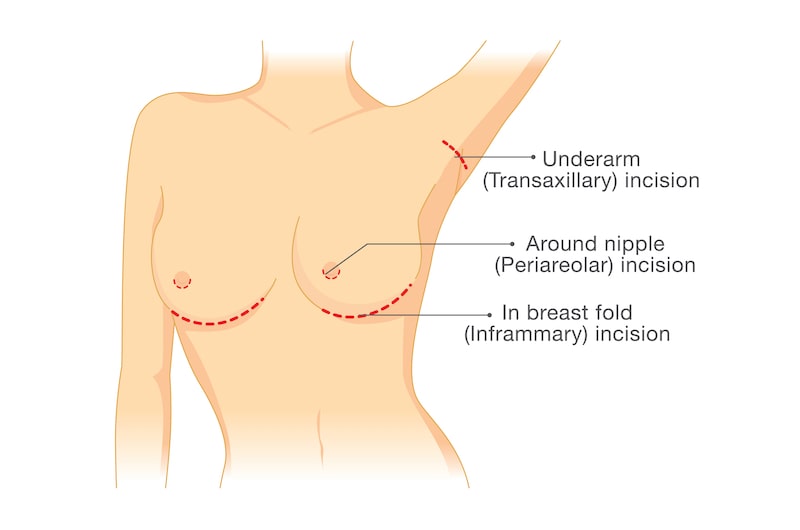Home|Blog | What Types of Incisions Can Be Performed With Breast Augmentation? Which Is Best for You?
What Types of Incisions Can Be Performed With Breast Augmentation? Which Is Best for You?
3 Minute Read:
When it comes to incisions for placing breast implants, your surgeon has several options. The most common incisions are the inframammary crease incision, the periareolar incision, and the transaxillary incision.

(Though not accurately represented in the diagram, all the incisions are similar in overall length.)
Various factors determine the best location for breast augmentation incisions.
Among them include:
- Implant type and size
- Shape of the implant
- Individual’s anatomy
- Preference of the patient or surgeon
Incisions will also differ if a patient is combining breast surgeries, such as a breast augmentation with a breast lift.
What Are the Major Incision Types Used for Breast Augmentation?
Inframammary Approach
The inframammary approach is the most commonly used option for breast augmentation. This incision is situated in or near the crease under the breast and offers excellent access and visualization for creating a precise implant pocket. This is the most versatile incision, and all sizes and types of breast implants can be inserted through it.
Importantly, its usage is associated with the lowest rate of complications (as compared to the other approaches). The scar that results usually heals very well and is generally inconspicuous.
Finally, this approach is most often used and needed when subsequent breast revision surgery is done.
Periareolar Approach
The periareolar approach involves placing an incision along the pigmented areolar skin through which the implant is placed. The “selling” point for this approach is that the resulting scar “may” be hidden “when” (if) proper healing occurs. In addition, because of its central location, pocket dissection for the implant may be relatively precise.
However, the periareolar incision can be associated with several significant problems, including a higher rate of capsular contracture, a greater risk for decreased or loss of sensation and sensuality, a negative impact on the ability to breastfeed, and breast and areola scar and contour deformities.
Since the incision is located at a major focal point of the breast, deformities that can—and do—frequently develop will truly be disheartening and substantially detract from the overall results.
Transaxillary Approach
This approach involves placing an incision in a crease of the armpit through which the pocket is dissected, and the implant is inserted. The main attraction of this technique is that there are no scars on the breasts. Though they usually heal inconspicuously, they may be very difficult to camouflage or hide if they don’t, especially when wearing a top that doesn’t have sleeves.
Another common drawback of this procedure is that it offers far less control and precision when placing the implant since direct visualization is not possible without using an endoscope. Consequently, for better and more predictable results, this procedure needs to be done endoscopically.
Interested in Learning Which Breast Augmentation Incision Is Right for You?
During your consultation with a plastic surgeon, make sure that you understand which incision is recommended for your breast augmentation and why. If you have any questions about it, ask!
Contact us at 480-451-3000 or fill out our online form to schedule an in-office consultation or a virtual consultation, and let our experienced plastic surgeon, Dr. Steven Turkeltaub, determine the best approach for you.
